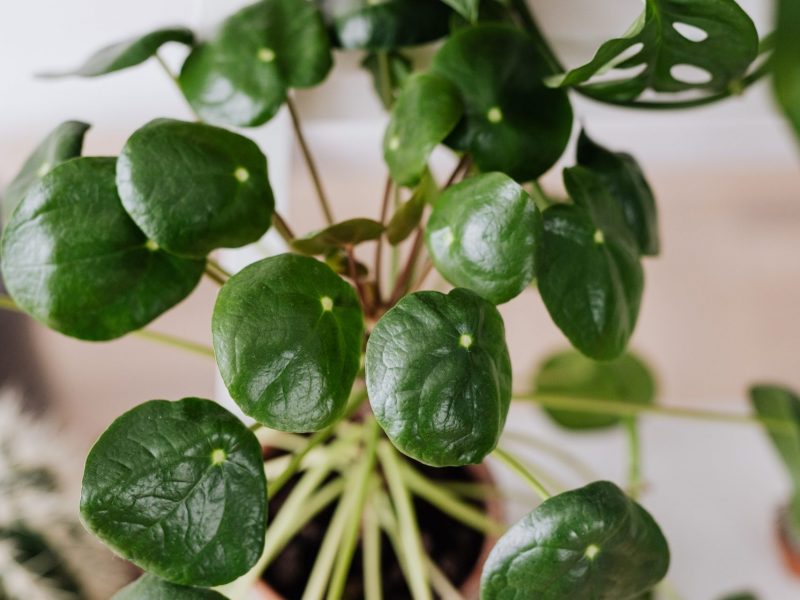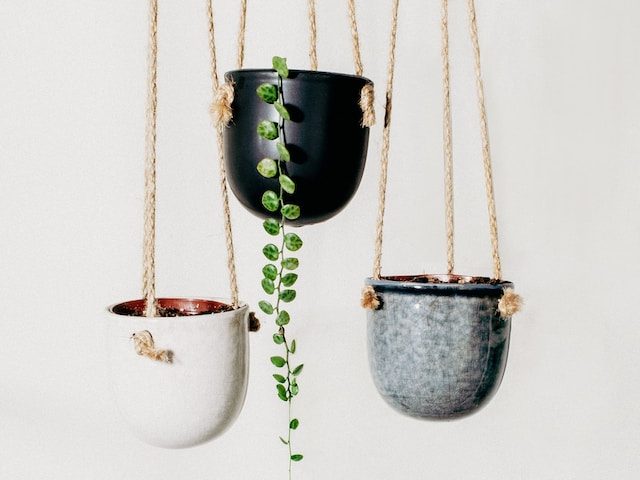
Pilea, also known as Chinese Money plants (because of their round leaves), can be quite sensitive plants. They are a little fussy when it comes to their environment which can mean they begin to drop leaves quite often. There are quite a few reasons why your pilea might be losing its leaves, the main ones being overwatering, not enough light, stress, dry air, nutrient deficiency, and pest infestation.
Overwatering could cause leaf drop in Pileas
As with a lot of things in the houseplant world, proper watering can be one of the biggest issues. Overwatering is a key concern when it comes to Pilea, and it can be a major reason why leaves may be dropping off.
We always tend to go for a little and often view towards watering and this is especially the case with Pilea. They don’t like their soil to be too dry but hate it even more if they are sat in water for too long. This can very quickly cause root rot which will mean leaves start to drop and the whole plant becomes quite unstable. If you think your Pilea might be suffering from root rot, it’s important to check right away and change out the soil if needed.
We recommend picking up your Pilea before and after watering. This should give you a feel for when your Pilea might need a little more water, simply by giving them a lift. You can also use a moisture meter to see when your Pilea needs watering. You just pop them into the soil and it’ll show you how damp or dry the potting mix is.
Another thing you can do to avoid overwatering is use a self-watering pot or self-watering globes. They release water to your Pilea only when it needs it and will help to avoid waterlogged soil and root rot.
Lack of sunlight could be the problem
Pilea thrive in bright, indirect sunlight and can really struggle with anything less. Make sure you place them somewhere they receive several hours of bright sunshine but keep them away from any direct sunlight as this can very quickly burn their leaves (and there is no going back from that, unfortunately). If your Pilea is getting too little sunshine, they will often shed some of the older leaves to keep their energy reserves for the new healthy growth. So make sure to move your Pilea somewhere brighter and it should stop shedding its leaves.
Using a light meter can be really handy to figure out if your Pilea is in the right place and getting the right amount of sunlight. Light levels can really differ throughout the day and throughout the year as well so it’s important to keep an eye on it as a lack of sunlight (and too much) can cause a lot of issues. We love this light meter which you can pick up from Amazon.
Complete Houseplant Care eBook
Our comprehensive (and rather good looking) eBook that will teach you everything you need to know to successfully care for, and maintain your houseplants!
Buy onYour Pilea could be stressed
Much like humans, pilea can get pretty stressed out if any changes occur. Things like repotting, propagating or moving to a new spot can cause your plant to get a little shocked and drop a few leaves. It is nothing to worry about and it will just take some time for your pilea to return to normal and for healthy growth to continue.
One thing to make sure of if you have moved your pilea to a new spot is that the conditions are the same, if not better than the one it was previously in. Your plant will struggle with worse light conditions so just keep a close eye on it for a while to see how it is coping in its new spot. Using a light meter and digital thermometers are a great way to check the environment.
The air is too dry for your Pilea
Pilea prefer a more humid environment, so if your home tends to have dry air it’s worth your time to try and increase the humidity a little as this can often be a reason why your plant is dropping its leaves.
There are few really simple techniques to keep the humidity higher than normal for your Pilea; you can mist the leaves with a spray bottle every few days (we love these amber glass bottles from Amazon) or maybe sit your plant in a tray with water and some pebbles. The most consistent way to increase the humidity is to use a humidifier near your Pilea.
You can also always pick up a good humidity monitor to keep track of everything if you’re more concerned. Make sure to also move your Pilea away from any air conditioning units as these create very dry air!
Lack of nutrients in the soil
Your pilea may be dropping leaves because of nutrient issues. It’s a safe bet to swap out some of the soil in the pot (that isn’t filled with roots) with a good rich potting mix or compost. We also use a liquid fertiliser during summer to help with growth.
From there it’s good to consider the water you’re giving to your Pilea. If you’re from an area with particularly hard water, your pilea could be getting too much calcium. It’s rare that this causes any real issues, but if you’re concerned, make sure you replace the soil a little bit more often as calcium toxicity can reduce the uptake of other nutrients.
Your Pilea could be in the wrong temperature
As you know by now, Pilea are very sensitive to their environments and this includes temperature. If your pilea is getting too much sunlight, it will also cause it to overheat which can cause it to lose some leaves. The perfect spot for your plant is just a touch further inside a bright room, potentially an east-facing window if there’s a good spot free.
If you’re not already, make sure to open your windows every now and then to make sure that the air in your room is circulating properly. This reduces the risk of hotspots forming in the room where your Pilea is sat. The ideal temperature for Pilea is between 18°C – 24°C, so it shouldn’t be too difficult to keep in a good range. You can always pick up a digital thermometer to check the spot your Pilea is sat for piece of mind.
Your Pilea could have become pot bound
With the possibility of causing multiple other issues, apart from a loss of leaves, root crowding in your Pilea is worth checking every so often. Let your plant dry out for a couple of days after watering and then gently lift it from its pot, if all you can see are roots then it seems like overcrowding could be the reason why your pilea is losing leaves.
Find a pot that is no more than a few centimetres bigger in diameter than the one before. If you repot your pilea into a pot much bigger than before, the roots will struggle to keep the plant stable. Repot with some more nutrient-rich soil and gently dig through the roots with your fingers to separate them out a little before repotting your plant with a little bit more room to grow.
If you find that when you take your Pilea from its pot that some of the roots have turned brown and soft then you could be in for the far bigger problem of root rot. In this case make sure to repot as soon as you can, removing as many of the infected (brown) roots as possible. You can read all about how to prevent, spot and fix root rot in our guide.
Pest infestation could be harming your Pilea
It is good to check the underside of the leaves that have fallen off, as well as the healthy leaves for signs of pests. If you find bugs, wipe each leaf with warm soapy water to try and remove as many as possible. We tend to recommend giving your plants a shower but pilea are quite sensitive plants so the water pressure can easily damage the delicate stems.
It is also good to treat your pilea with neem oil to fight the infestation. Make sure to check over your other plants in the room to see if any other plants have pests. Make sure to keep your pilea (and other infected plants) a good distance away from any of your other houseplants as you don’t want the infection to spread.
There is quite a range of reasons why your pilea may be losing leaves. It is good to go through the list and eliminate the ones that you think are definitely not the cause and go from there. Once you have diagnosed the problem, make sure to keep a close eye on your pilea to check that no other problems are developing. Even though pilea are quite demanding and sensitive plants, they are one of the most beautiful and will repay you for taking good care of it!














